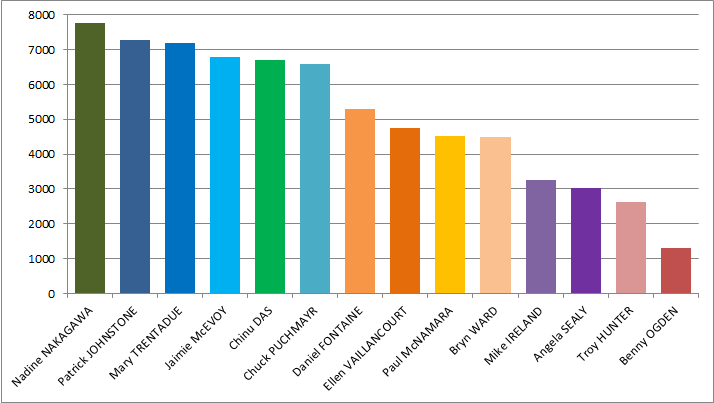I have avoided talking too much about the election over here, relying on my election website to carry the campaign load while I kept this site on the day-to-day of council life. However, I am going to spend a bit of time between now and the resumption of Council stuff in November looking back at the election.
I am still thanking my many volunteers and supporters, the feelings are still a little raw, and lots of Monday morning quarterbacking is going on, so I am going to hold off on all that stuff for a bit and start with just the (preliminary, not yet official!) numbers, starting with number of votes:

On Council, Team Cote clearly dominated, not only taking the top 6 spots, but doing so with a clear numbers gap over the members of the NWP Party (6th place had 25% more votes than 7th place), who in turn had a pretty solid gap ahead of the 4 independent candidates (10th place had 38% more votes than 11th).
Voting percentages are a little wonky for Council elections because we don’t know how many votes each voter decided cast, but there were 71,627 council votes and 14,368 votes for Mayor, so we can infer an average of 5 votes per voter. There were something like 50,000 registered voters in New Westminster, so turnout it tentatively a little over 28%, about the same as last election (the exact numbers will have to wait until the official report- as we don’t know how many voters registered on the day of the election) .

The pie chart allows a little more clumping analysis. We can see that Team Cote candidates earned 59% of the vote total, NWP candidates 27%, and others 14%. Of course, there were 50% more Team Cote candidates than the others, so perhaps a better comparison is that the average Team Cote candidate earned 9.9% of the votes, the average NWP candidate 6.7%, and the average Other 3.6%.
Nadine Nakagawa surprised even herself by dominating the vote. The last time a rookie candidate led the polls for Council was in 1996 when a young Jerry Dobrovolny pulled off the feat. The vote count of all 6 elected Councillors (7,764 to 6,595) is quite a bit higher than last election (6,262 – 5,517), though the vote count for the 7th place finishers is not that different (5,297 in 2018, 5,165 in 2014).
For the fun of it, I made a bar chart mixing this year’s election results (blue) with last elections (in red) so you can get a sense of how the vote distribution changed:

There were more candidates in 2014, which makes for a longer tail on the distribution, but this display really makes the gap between Team Cote candidates and others stand out – getting about 20% more votes than their cohort in the previous election, where the NWP had very similar vote counts as their 2014 cohorts. This was a convincing win compared to last election.
On the School Board side, things are not as clear. The Team Cote candidate still swept the top spots, but the vote count was much closer:
There also isn’t a big gap between 7th place (and elected) and 8th place (less than 4%). The NWP candidates were not clustered, it is clear there was no “block vote” for or against the NWP. Danielle Connolly got 25% more vote than the NWP average, J.P.LeBerg got almost 30% fewer votes than that average.
The average ballot included 5 Trustee votes (72,335 compared to 14,368 for Mayor, see assumptions above) – curiously the same average as for Council even with one more opportunity to vote, and they broke down like this:
43% of the votes went to Team Cote candidates, 25% to NWP candidates, and 32% to others. Again, since there were different numbers of candidates in those three clumps, the better estimate may be that the average Team Cote candidate earned 8.7% of the vote (and all were pretty close), the average NWP candidate 6.2% (with a wide spread), and the average Other 4.5% (with two candidates standing well above the average).

The comparison between 2014 and 2018 is more interesting here than with Council. There were more votes in 2018 (about 14% more), but in contrast to Council, less of that vote went to the front-runners. With more candidates in 2018 the distribution is more spread out, but it will take a smarter political scientist than me to tell what this means!
Finally, in a campaign where there was much discussion of how diversity was defined, all of the new candidates elected were women – three on City Council and six (6!) to the School Board. This, and the cultural diversity of the candidates, may be historic for New Westminster. Though it is worth noting that between 1993 and 1996, there were three women on New Westminster Council, and Betty Toporowski was Mayor. Whether a person of colour has ever served on Council in New Westminster is the kind of question you would need to ask an historian.